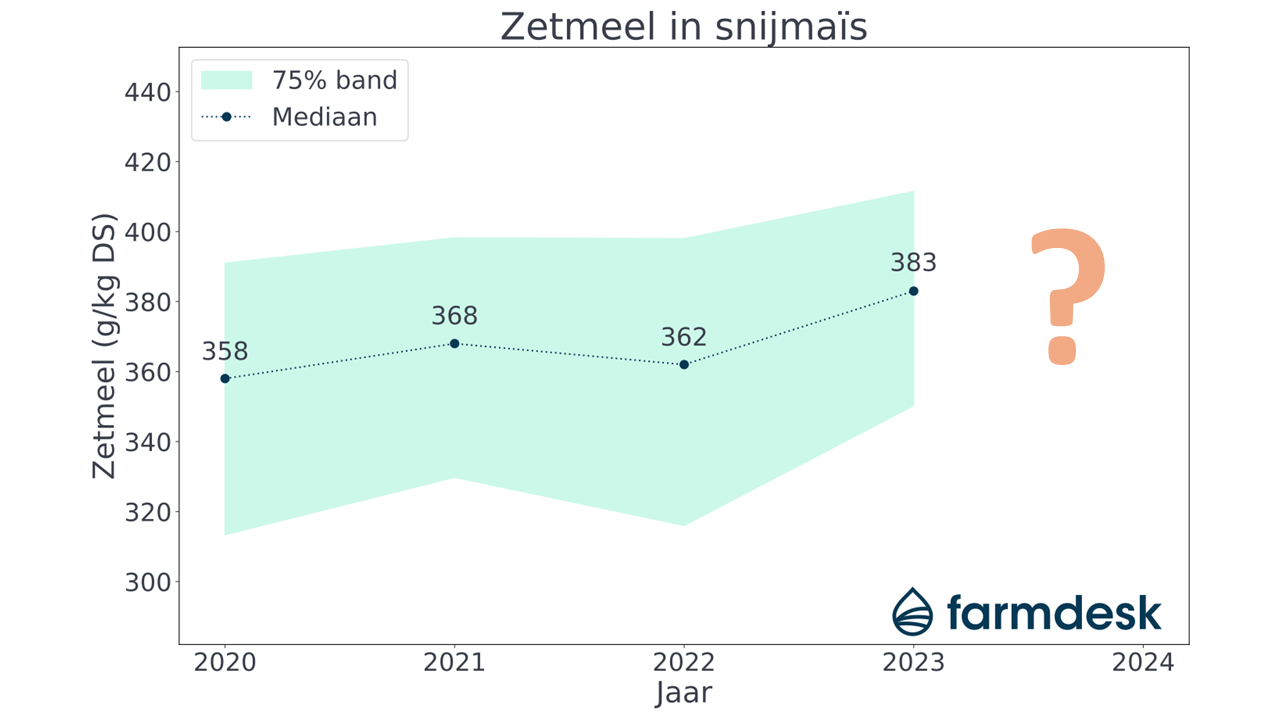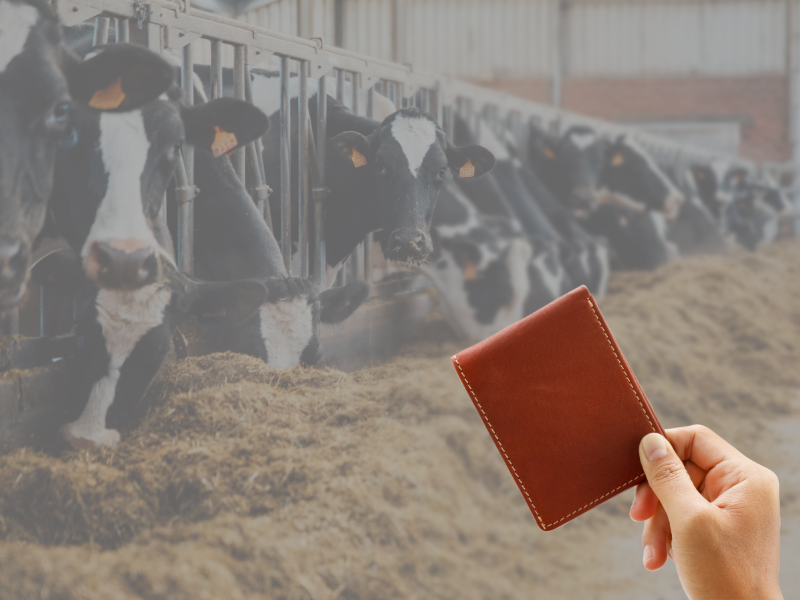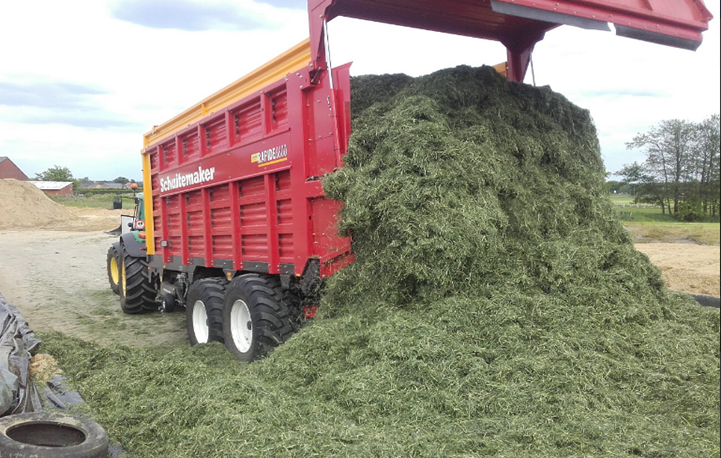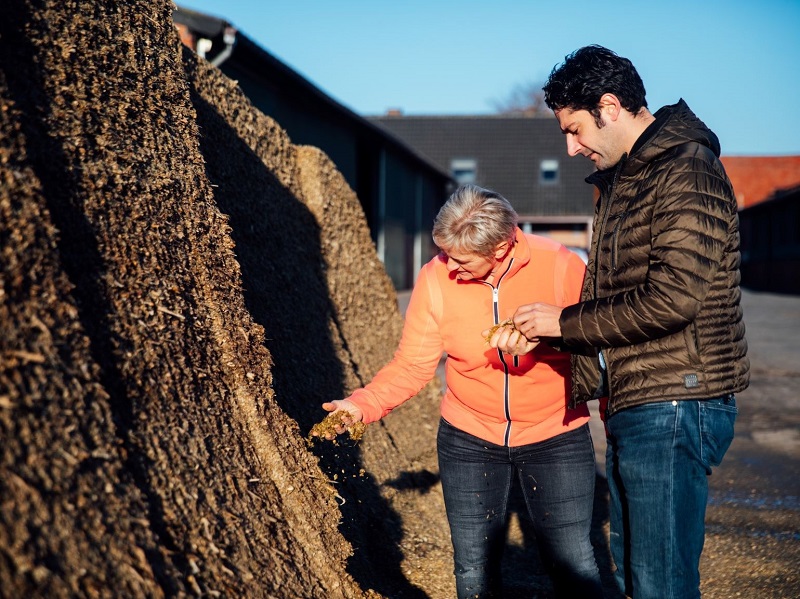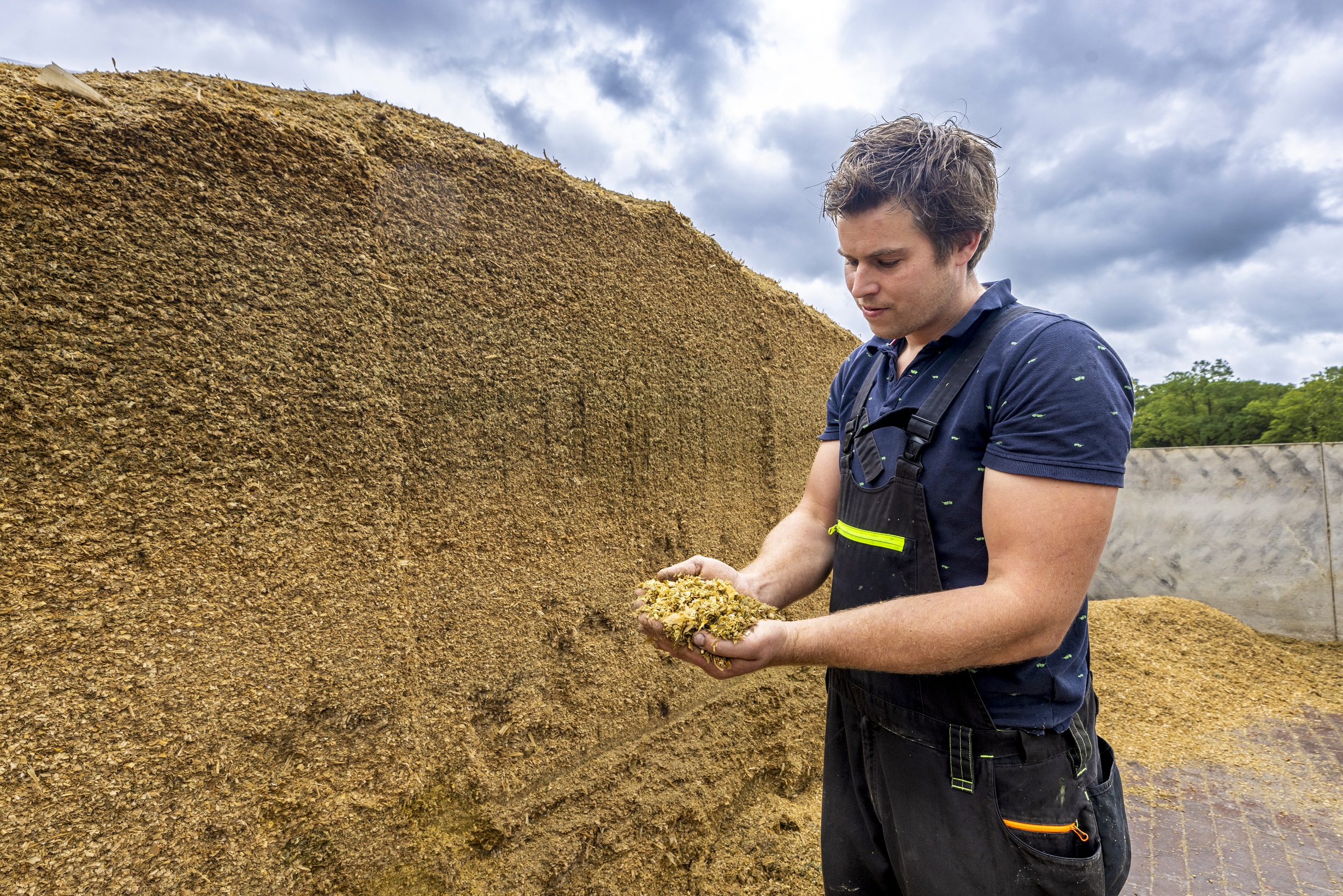Producing and harvesting good grass (clover), cut rye or other forages is the trick, but it doesn't stop there. Making these feedstuffs preservable until everything is absorbed by the cattle is the challenge.
Natural or artificial drying into hay would be a good solution for grass, grass-clover or alfalfa, but often silaging of feedstuffs is chosen. This ensiling is an anaerobic process, relying mainly on lactic acid bacteria that lower the pH of the silage, preventing other microorganisms from growing.
Before ensiling
Crop growth
Sufficient sunshine on crops produces sufficient sugar. This sugar is necessary to feed lactic acid bacteria for the purpose of lactic acid production, which is necessary to lower the pH.
Several days of sunshine in the crop and preferably mowing in the afternoon gives more chance of sugar in the crop. If the nights are cold the sugar accumulates the most, because then it is not lost during the night by respiration.
Little earth
Little soil in the harvested crop is important in order to leave enough space for digestible feedstuffs in the rumen.
The seed bed is already important, billiard sheet flat is the objective. Moles are not welcome and should be controlled, the mower should be properly adjusted, preferably not mow lower than 7 cm and the tedder and rake should not mix soil with the forage. The pick-up of the pick-up truck, chipper or baler should not go too deep through the earth.
A paved clean driveway at the pit is important to avoid introducing sludge into the pit through the tires.
Speed
A short field period prevents losses due to resprouting. Best is to mow in the afternoon with conditioner which accelerates drying, shake in the morning after dew if necessary, rake shortly after noon to begin picking up, chopping or baling a few hours later to get to about 40% DS (depending on forage) in good weather. Call this the optimum speed in field operations for ensiling.
Preservation
In practice, we refer to this as ensiling. Ensiling is storing feed materials with a relatively high moisture content through "controlled" fermentation.
The temporarily still aerobic phase
Oxygen is always included in the ensilage process. As long as this is present, the plant enzymes continue to work and we potentially lose energy and thus feed value. The energy released produces heat. Silages that heat very much become brown and harder to digest. In addition to these plant enzymes, there are microorganisms present in the silage that take advantage of this aerobic phase and produce heat which results in energy loss.
The anaerobic phase
The initiation of acidification is by coli bacteria, these coli-aerogenes group initiate acidification (oxygen may even be present). They work at a temperature of 25 - 35°C and stop at a temperature of 50°C and above and/or at a pH <4.5. They convert carbohydrates to; acetic acid, formic acid, ethanol, lactic acid, (butyric acid) and CO2. Some species of this group also break down proteins to NH3 and amines, which is undesirable.
The rapid pH drop occurs in a subsequent truly anaerobic phase by desirable lactic acid formers. Lactic acid bacteria convert water-soluble carbohydrates to lactic acid. Lactic acid is a strong organic acid and lowers the pH. This drop complicates microbial life. At a pH of 4.2, most processes are stopped.
If the pH drops below 3.5, then also the action of the lactic acid bacteria stops, in addition, all enzymatic activity also stops and the silage becomes completely stable. In many cases the silage pH does not drop to these values, but the silage pH must drop below the critical pH to be somewhat stable. This critical pH depends on the percentage of dry matter and the osmotic pressure of the of the silage.
The critical pH varies with the dry matter percentage of the silage:
DS(%)
15
20
25
30
35
40
45
50
Critical pH
4.1
4.2
4.35
4.45
4.5
4.75
4.85
5.0
The lactic acidifiers are classified into 2 groups: The homofermantative lactic acid bacteria, these produce only lactic acid from carbohydrates and the heterofermentative lactic acid bacteria, these produce lactic acid, acetic acid, alcohols, CO2, etc. from carbohydrates, which is less acidifying than lactic acid alone.
Under normal conditions, critical pH is reached in 17 to 21 days.
Problems
Butyric acid-forming clostridium bacteria can form butyric acid from carbohydrates or even from lactic acid when pH is too high, osmotic pressure is low or in the presence of oxygen. Certain clostridium bacteria can even break down proteins and amino acids, causing the feed value to drop, the ammonia fraction to rise and the pH to rise further.
With new oxygen in the silage, whether stable or not, organic acids and remaining carbohydrates can be converted to CO2, water and heat, resulting in growth with feed value decline.
Butyric acid bacteria or spores thereof present in the feed by multiplication can give rise to butyric acid bacteria or spores in the barn environment and thus end up on the teats or udder, increasing the likelihood that they will end up in the milk. This can mess up the cheese-making process, which is why some dairies are even going to give a fine on delivery of this milk.
Listeria bacteria can also thrive at high pH because of improper storage. These give rise to health problems in the cattle, possibly resulting in death; listeriosis.
Mycotoxins are produced by certain fungi and are toxic to animals. We distinguish 2 major groups; field fungi (such as Fusarium) and storage fungi (such as Penicillium and Aspergillus).
Rather sugar-rich silage that are ensiled fairly dry (>50% ds) are sometimes affected by alcohol and/or ether fermentation during ensiling. Wonderful as a farmer to work in an environment with a silage that smells like gin or jegenmeister! For the ruminants, however, this can pose a problem. The alcolhols or ethers will have an antiseptic effect and, as a result, they can also give rise to a negative influence on rumen flora, which is precisely not desirable in highly productive ruminant cattle.
Points of interest
- Provide sugar-rich starting material.
- Increase osmotic pressure by pre-drying.
- Keep a short field period.
- Drive the pit carefully to get all the air out.
- Quickly make the pit airtight.
Inserts
Add sugars when sugar is tight. In the autumn or after a cloudy growing period, this may be desirable with sugar-poor starting material. For example, 100 kg of molasses per ha of grass.
Add lactic acid bacteria that convert the sugar to lactic acid. Various mixtures are on the market. Make sure they must also encounter sugar in the silage, otherwise they will starve to death.
If the silage cannot be made dry enough because of the weather, salt administration can help increase osmotic pressure. Be careful not to exceed the cattle's salt requirements with the addition of salt.
Sometimes even organic acids are added to the silage to lower the pH. Acetic acid and propionic acid are internal metabolites of the beef and certainly cannot cause a problem in the animal.
Adding enzymes can be interesting to already initiate the pre-digestion of the feed materials.
Silage
During ensiling, the feed comes into contact with oxygen. This allows unwanted bacteria, yeasts and fungi to start growing, which we call scalding. We may get pH rise, temperature rise, energy loss, protein conversion and mycotoxin formation. This is ever detrimental to the cattle. Careful ensilage with a tight ensilage cut and little movement of feed in the silage, give the least chance of scalding.
In case of danger of mycotoxins in the feed, mycotoxin binders can be co-fed.
Spraying the silage cut with propionic acid can help. Sometimes when a silage is susceptible to fouling, propionic acid is added to the mixing wagon to prevent the heating process from continuing rapidly in the feed alley. This can have a good effect, but don't combine this with, say, sodium bicarbonate in hot weather or rapidly digestible rations. The bicarbonate will react as a base with the propionic acid as an acid and both will dissolve into water and CO2.
To improve the ensilageability of feedstuffs, it is opportune to control the dry matter content of the silage based on crop qualities. A stalky forage requires a rather moist silage to minimize ensilage problems. For example, a late-harvested cut cereal will benefit from no field period to ensure that the silage cut of the forage causes as little heating afterwards as possible. In turn, a young leafy cut cereal will benefit from as dry a product as possible toward the 40% ds to ensure that the DVE/OEB improves. This leafy product will have much less tendency for air ingress at the silage cut so the risk of scalding is more likely to be limited.


